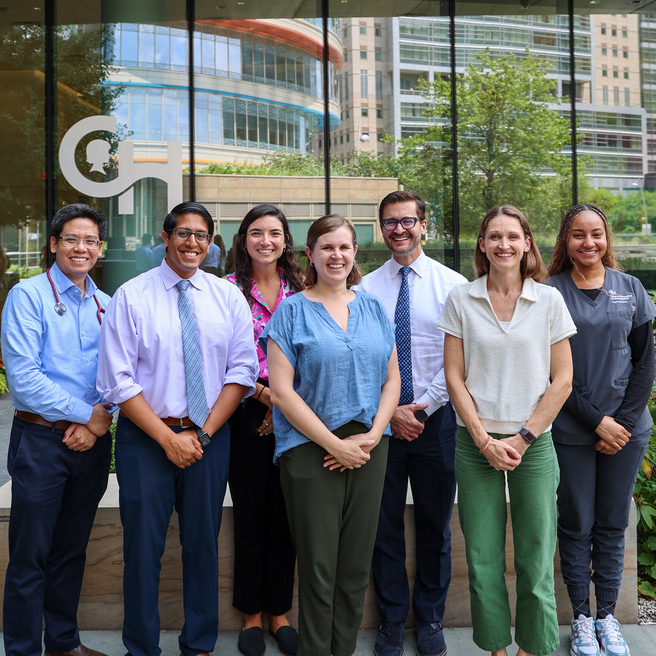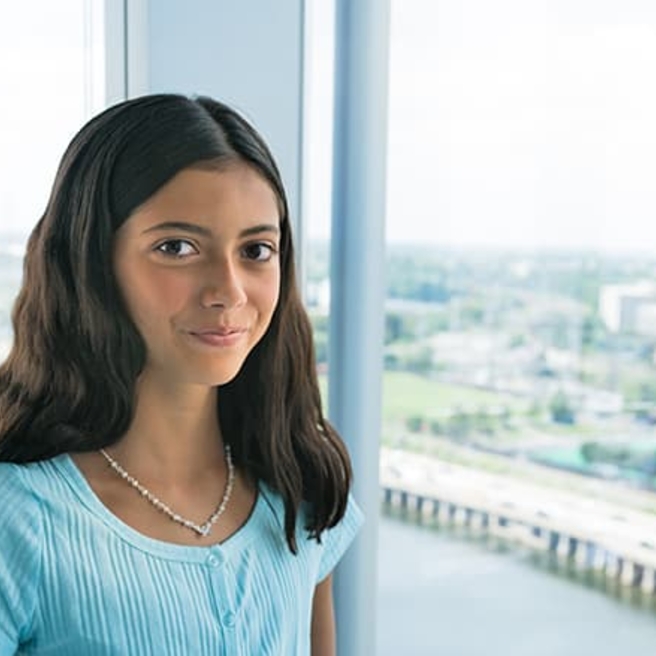What are kidney stones?
Normally, urine contains many dissolved molecules. When some molecules become concentrated in the urine, crystals form that can lead to the development of stones. Most kidney stones contain calcium, specifically calcium oxalate. Other types of stones contain minerals such as calcium phosphate, uric acid, cystine and struvite.
Kidney stones were once thought of as an adult diagnosis. But kidney stones in children have been on the rise for the past few decades. The Divisions of Urology and Nephrology used to treat just a handful of children with kidney stones a year, but today we are diagnosing, managing and treating children with kidney stones daily.
Watch our educational video series to learn more about our approach to treating kidney stones at Children's Hospital of Philadelphia.
Causes of kidney stones
Risk factors
According to the National Institutes of Health (NIH), 1 out of every 9 people will develop kidney stones during their lifetime.
Diet, genetics and lifestyle can all contribute to kidney stones. Several risk factors play major roles in stone formation:
- Loss of body fluids (dehydration). If your child does not drink enough fluids during the day, their urine can become quite concentrated. This increases the chance for crystals to form in the urine.
- Diet. The type of food your child eats can also affect their chances of getting kidney stones.
- Eating way too much protein. A diet with excessive protein can cause the uric acid and calcium in the body to increase. It can also decrease the amount of urinary citrate, a "good" chemical that helps prevent stones. As a result, stones are more likely to form.
- Getting too much sodium. A high-salt diet is another risk factor. An increased amount of sodium passing into the urine can pull calcium along with it. This increases calcium levels in the urine, which increases the chance for stones.
- Not getting enough calcium. Not getting enough calcium can increase oxalate in the urine. Eating oxalate-rich foods such as dark chocolate, black tea, dark sodas, instant coffee, and soy drinks can increase the risk for calcium oxalate stones.
- A family history of stones, especially in a parent or sibling, increases the chance of having stones.
Conditions affecting kidney function can contribute to kidney stones such as:
- Primary xanthinuria
- Primary hyperoxaluria
- Cystinuria
- Dent's Disease (X-linked Nephrolithiasis)
- Glomerular Disease
Signs and symptoms of kidney stones
Once stones form in the urinary tract, they may grow over time and move within the kidney. Some stones may be washed out of the kidney by urine flow and end up stuck in the tube that carries urine from the kidney to the bladder (also called the “ureter”). Stones usually begin causing symptoms when they block the outflow of the urine to the bladder.
Symptoms of an obstructing stone can vary. Most often, patients will complain of pain in their sides. This pain may also move toward the front of the abdomen or to the groin area. Younger children may experience general abdominal pain.
Testing and diagnosis
If we suspect that your child has kidney stones, we'll perform a physical exam and take a careful comprehensive medical and family history. Blood, urine, and saliva tests can help to determine the causes of kidney stone formation.
Imaging studies can give your urologist information about the size, location and number of stones that are causing the symptoms. A renal bladder ultrasound is the primary imaging study used to find and characterize stones and to identify signs of blockage. If the ultrasound does not provide enough information to make a diagnosis, an abdominal/pelvic CT scan will be done. This test can detect almost all types of urinary stones.
CHOP Radiology offers the most advanced diagnostic imaging for kidney stones, including state-of-the-art ultrasound and dual-energy CT imaging, which can provide information about the makeup of each kidney stone without surgical removal.
A thorough evaluation allows your physician to offer the best treatments for your child.
Treatment for kidney stones
Many factors must be considered in the diagnosis, management and treatment of children with kidney stones. To address the unique needs of children with kidney stones, we created the Pediatric Kidney Stone Center, a program within the Divisions of Urology and Nephrology that is solely dedicated to the management of kidney stones.
The CHOP Pediatric Kidney Stone Center is one of the largest, most advanced kidney stone centers in the nation. We’ve evaluated and treated more than 2,300 patients and conducted more than 1,100 surgical procedures to remove kidney stones.
Urologists and Nephrologists (doctors who focus on kidney health) work closely to treat patients seen at the Kidney Stone Center
You might not know much about kidney stones or even be surprised that your child has been diagnosed with one. We are committed to helping you and your child understand this diagnosis and every step of your tailored management plan. Treatment options may include medications, dietary therapy, nutritional counseling, or surgery.
We have an experienced surgical staff who use the most-advanced surgical equipment available in any children’s hospital to perform minimally invasive surgery (MIS) whenever surgical intervention is needed. Our outpatient management team helps families manage active stone disease and prevent stone recurrence. Child life specialists and uropsychologists are available to provide additional support and age-appropriate education.
To choose the best treatment for your child, your doctor will consider the size of the stone, the number of stones and their location. Most small stones can pass on their own. We may ask your child to ‘strain’ their urine with a special filter so we can send the stone for testing, if necessary, to determine what kind of stone it is.
Surgery may be needed if a stone:
- Does not pass within a month, a fever develops, or causes constant pain
- Is too large to pass on its own
- Blocks the flow or urine
- Causes urinary tract infection
- Damages the kidney or causes bleeding
- Has grown larger (as seen on follow-up imaging studies)
Procedures to remove kidney stones
We use several procedures to remove kidney stones. These procedures include:
- Shockwave Lithotripsy – This is a noninvasive procedure performed under general anesthesia that’s effective for stones in the kidney or ureter. During the procedure, we use ultrasound to find the kidney (ultrasound is an imaging method that does not use radiation). Then, a machine called a lithotripter is used to generate shockwaves that are focused on the stone. The pulse from the shockwaves breaks the stone into very small particles that are then passed in the urine. Shockwave lithotripsy is an outpatient procedure, meaning that after recovering from surgery for a few hours, your child can go home; they typically do not need to stay at the hospital overnight. Lithotripsy is not appropriate for children with very large stones or other medical conditions. Watch a video for more information about Shockwave Lithotripsy Surgery at CHOP.
- Ureteroscopy – This is a minimally invasive procedure with no incisions. It is typically done for small to medium-sized stones. A very small scope, called a ureteroscope, is inserted into the ureter to visualize the kidney stone. The urologist can see the kidney stone in real-time on a monitor and use a laser to break the stone up into very small particles that can be passed in the urine. After the ureteroscopy, a thin plastic tube called a ureteral stent may be needed. The stent may be left in the kidney anywhere from a few days to a few weeks to promote healing and prevent blockage from swelling or spasm. Ureteroscopy is an outpatient procedure, meaning that after the surgery, your child can go home after recovering for about an hour or two. Watch a video for more information about Ureteroscopy Surgery at CHOP.
- Percutaneous nephrostolithotomy (PCNL) – This is a minimally invasive procedure performed in the hospital under general anesthesia to remove large or complex kidney stones. For the PCNL procedure, a small incision is made on back right side, underneath the rib cage (you might also hear this section called the “flank”). Through that incision, the urologist uses a scope to go directly into the kidney, locate the stone or stones, and then break them up with either a laser or an ultrasound device. After a PCNL, usually a temporary device for urinary drainage is needed, whether a stent or a nephrostomy tube, that directly drains urine from the kidney. Depending on which tube is used, the tube may be removed a few days to a few weeks after the procedure. This procedure usually requires hospitalization and most children resume normal activity within two weeks. Watch a video for more information about PCNL Surgery at CHOP.
What to expect after treatment for kidney stones
Although each patient is different, there is about a 50% chance of having another stone within the next three years after treatment. Our goal is to prevent stones from occurring. Read more about kidney stone recurrence here.
To help us determine what caused the kidney stone, we will ask your child to collect urine for 24 hours to measure urine volume and levels of acidity, calcium, sodium, uric acid, oxalate, citrate and creatinine. Your child may also be asked to have a blood test to help us understand the reason their body is forming stones.
Prevention
There are things you can do to help prevent kidney stones from forming. Prevention can be very personal. We can help guide you to the right prevention measures depending on the type of stone your child produced, their underlying risk factors, and how willing they might be to stick to a long-term prevention plan. Your child may need to change certain habits, such as drinking more fluids and changing their diet.
We recommend children with stone disease:
- Drink a minimum of half of their body weight in ounces of water daily. For example, an 80-pound child would drink 40 oz. of water each day. Proper hydration helps prevent the urine from becoming concentrated with crystals, which can lead to stones forming. It also reduces the risk for urinary tract infections, which can cause struvite stones.
The color of your child's urine may give clues to the concentration of crystal: dark or bright yellow urine indicates highly concentrated urine, whereas pale or colorless urine indicates less concentrated urine. Lemonade with real lemon juice is a good source of citrate and may be recommended as an alternative to water.
Remember, the type of fluid matters. Coconut water and lemonade help excrete more citrate in the urine (which is good – this is preventative) whereas cranberry juice can increase the risk of calcium oxalate and uric acid stones. Water is always the preferred and best fluid for stones prevention. - Limit meat, salt and foods high in oxalate.
- Protein is important for growing bodies. Your child can still eat the recommended amount of protein. But avoiding excessive protein intake can help prevent stones from coming back.
- Try to help your child limit their sodium intake to <2000 mg/day. Foods high in sodium are foods high in salt such as canned foods, some frozen foods and processed foods and drinks.
- You can help prevent oxalate stones by helping your child avoid high-oxalate foods such as cocoa, dark chocolate, instant coffee, dark sodas, black tea, Ovaltine, high-oxalate fruits and vegetables, and soy drinks.
- Increase sources of citrate, whole grains and Omega-3 fatty acids.
- Urinary citrate is a “good” chemical that helps prevent stones. Foods like lemons, oranges, grapefruits, limes and melon are good sources of citrate and can help increase citrate in the urine.
- Increased intake of brans in whole grains, like oats, barley and farro can decrease calcium excretion in the urine.
- Omega-3 fatty acids can also decrease calcium excretion in the urine. Foods rich in omega-3s are flax seeds, chia seeds, walnuts, certain types of fish, and fish oil
- Important: Do not limit calcium in your child's diet. Doing this can actually increase the risk of kidney stones.
We also may give your child medication to prevent kidney stones. If your child has an underlying condition that causes kidney stones, we will treat that, as well.
Research
At CHOP’s Pediatric Kidney Stone Center, caring isn’t just our profession, it’s our purpose. We’re driven to innovate, heal, and change the lives of the children we treat.
Our team consists of the most experienced and knowledgeable experts in this field. Our years of research have transformed our understanding of early-onset kidney stone disease and positioned us to make the next breakthrough to improve the health of children with kidney stones.
At CHOP, a select group of programs are designated as Frontier Programs. They conduct visionary research that translates to lifesaving treatment and cures, and they offer answers often not available anywhere else in the world. The Pediatric Kidney Stone Center has been designated one of these elite Frontier Programs.
We are currently working to revolutionize how we diagnose and evaluate patients with kidney stone disease.
Right now, the way we diagnosis kidney stone disease is through a 24-hour urine collection test every 6 - 12 months. That means parents need to collect every drop of urine their child produces in a special container over a 24-hour period. We know that this can be difficult – especially with small children.
We are developing a new test that would enable earlier detection of kidney stones and provide a more detailed analysis of substances in a patient’s urine. This would be the first new urine test for kidney stone disease in 30 years. (Adults would benefit, too.)
More specifically, we’re studying patients’ gut and urine microbiomes and metabolomes. We are discovering molecules such as metabolites and proteins that are unique to pediatric kidney stone disease. These molecules could provide insight into severity of kidney stone disease and guide both surgical and medical treatment.
Our team is also creating a data hub to expedite research on the cause of stone disease. We hope to use this data platform to expand on our findings, which suggest that a loss of bacteria in the gut microbiome — the community of organisms in our intestines — may increase the risk of kidney stones.
All of this research is helping us find more effective treatments much quicker – all while using a simpler, more convenient and more expansive test.
Resources to help
Kidney Stones in Children Resources
Pediatric Kidney Stone Center Resources
Reviewed by Gregory E. Tasian, MD, MSc, MSCE
Reviewed on 07/08/2025


